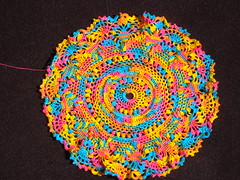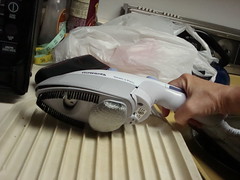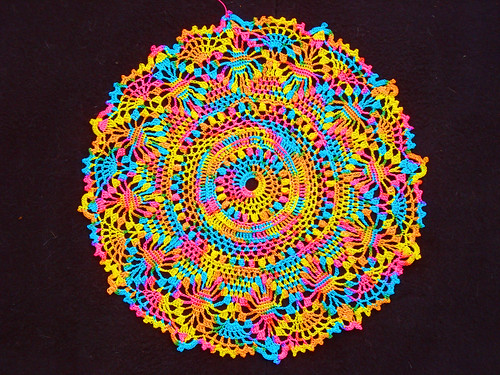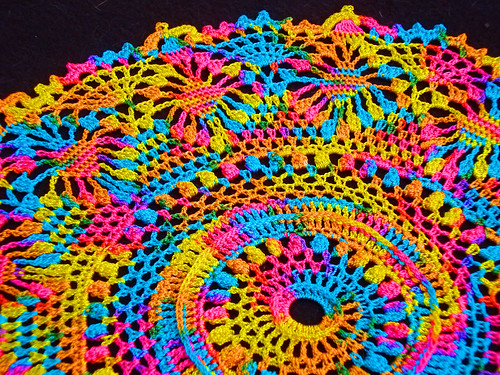But man-made fibers are a whole different game. Acrylics don't block well. You can wash, pin, let dry, unpin, and just watch the whole silly thing curl up or go back to its original shape and size.
But there's a procedure called "killing the acrylic."* You wash your project, pin it out nicely (so far, like regular blocking)...and then you steam the livin' daylights out of it. You have to be careful not to touch the yarn with the hot iron (there's a difference between killing the acrylic and cremating it), since acrylic will melt under that much heat. (It's why they don't make potholders out of acrylic yarn.) But you can put a damp towel over your piece while you iron, or you can just hold the iron over the piece and shoot steam jets at it. Then you let the piece dry again before you unpin it.
People who have done this to acrylic yarn say that the yarn becomes softer and has a nicer drape, and that it holds its blocked shape--permanently. (The good news is that you only block once. The bad news is that you only block once. You'd better get it right. And don't, for cryin' out loud, wash an acrylic item in superhot water and dry on a high dryer heat.)
So--does nylon count as an acrylic? "Acrylic" is such a generic name. Are there some acrylics that killing doesn't work with?
I once bought some nylon crochet thread. (The thread used for doilies usually is 100% cotton.) In fact, I've bought a few spools of it, but I'd never used the nylon for a doily. But in the interest of scientific research, I thought I'd see if killing the acrylic works for nylon.
So I crocheted a doily. I had a variegated thread in bright colors, so I chose a pattern than didn't have lots of textured stitches on top of other stitches (that doesn't show well in variegated thread). The nylon thread is a bit thinner than conventional doily thread, I think, and my doily came out a bit smaller than the size specified:

At this point, the unblocked doily measured about 12 inches; the pattern specified 16 inches. So I washed it and pinned it out. Stretched out for blocking, it was about 13.5 inches--still smaller than the pattern specs. I steamed it some while it was pinned. I let it dry overnight while pinned.

After it dried, I steamed it--with my Rowenta Steam 'n Press iron, which has a protective piece you can put on the bottom of the iron to make sure the baseplate doesn't touch the fiber. I let that sit overnight to dry. I took it off the blocking board and let it sit. The doily drew up some after it was unpinned, and went back to 12 inches unless I stretched it again. So, figure it really wants to be 12 inches.

Then I rewashed the doily and just tossed it on the blocking board, spread it out by hand, and made sure none of the picots were bent out of shape. I let it dry overnight, and it stayed nicely round, picots flat, and 12 inches.


It's not going to take special efforts to block it, so it looks like I've successfully killed the nylon. It's nice to know this is going to be possible on future doilies; I've just got to compensate for the size issues since this thread is finer.
*The joke goes like this: An inexperienced knitter asks "What's 'killing the acrylic'?" and the smart-ass knitter answers, "Red Heart." This is a knitter's in-joke; Red Heart Super Saver yarn is sort of the fast food of yarn. It's reasonably inexpensive, comes in some pretty colors, but is uncomfortable to wear (hot and it feels rough) and doesn't block at all. But it does wear well--machine wash and dry--making it a very good yarn for afghans.
4 comments:
Thanks for posting a tutorial. I am tempted to try this on the hat I just knit for my niece. :)
hi,
I liked your doily and the nice write-up about the blocking. I love making doilies and i block only cotton thread doilies. The nylon doilies (I have done just a few)in my opinion do not need blocking. I havent used omega, but the ones i get in India are kind of thick and stays in shape so well. However, after one washes it, it becomes limp. After starching they lose their sheen, that is my discovery.:)
The top photo shows the doily unblocked; the large picots don't stick out properly, so I needed to block it. And whoever I give it to would be facing the same problem any time they washed the doily.
The Omega thread did not go limp after washing; it's not actually limp even after steaming it. Since I haven't needed to starch it, the Omega thread is still nicely shiny even after washing, blocking, and steaming it. I'm sure I'll use it for more projects.
Excellent article, good information. Thank you!
Kathleen Hilner
Post a Comment